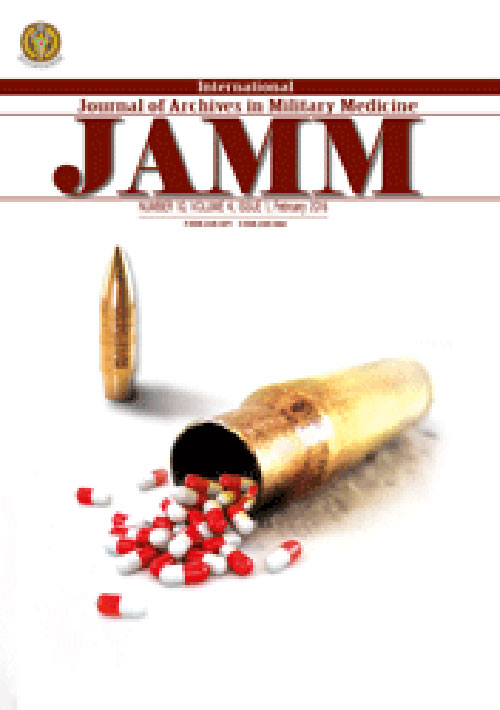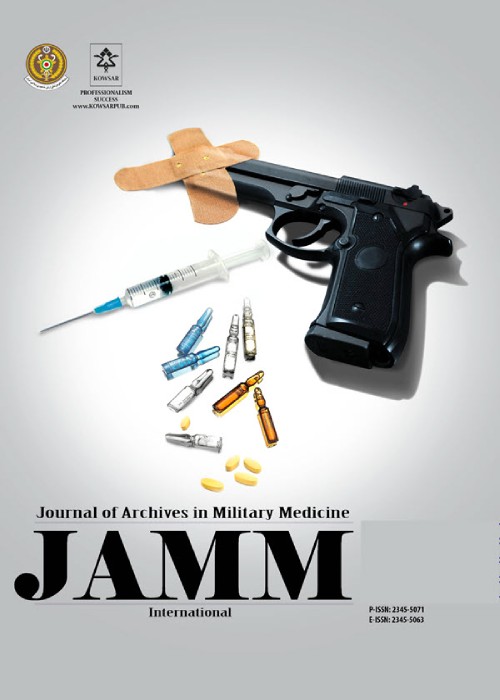فهرست مطالب

Journal of Archives in Military Medicine
Volume:6 Issue: 2, Jun 2018
- تاریخ انتشار: 1397/04/30
- تعداد عناوین: 4
-
-
Page 1BackgroundVaricella zoster (VZ) is a highly contagious exanthematous disease. The Indian VZ clade 5 has a high outbreak potential with attack rates of 90%, which thwarts all the infection control endeavors in hospital and institutional environments. Four VZ outbreaks occurring over four different years were investigated with military nursing students in a tertiary-care hospital in order to delineate infection control protocols.MethodsVZ outbreaks were investigated by hospital infection control committee utilizing standard definitions and protocols after establishing epidemiological linkage. A total of 114 nursing students were evaluated through a questionnaire developed to assess clinicodemographic, exposure, confinement and vaccination parameters. Outbreak control measures included isolation of patients; quarantined close-contacts and suspects; acyclovir treatment; immunization of susceptible candidates against VZ.ResultsThere were four different outbreaks comprising a total of 23 patients including five breakthrough patients with cumulative attack rate of 39%. Most patients had mild VZ. Most common sources were friends. Also, 25 students had no exposure to VZ or VZ vaccine, and were identified to be susceptible candidates and accordingly, were vaccinated.ConclusionsOutbreaks of VZ are emerging in the developing countries due to inadequate immunization coverage, primary failure to seroconvert, or failure to mount immune response despite seroconversion, or secondary failure due to waning immunity. Outbreaks of VZ may have variable epidemiological dynamics and may not be controlled with standard infection-control programs. There is a need to augment existing capabilities for optimizing outbreak management in institutional settings.Keywords: Outbreak, Varicella Zoster, Infection Control, Vaccination, Quarantine
-
Page 2BackgroundEmphasis on research issues and increased research activities leads to development and progress and brings about real self-sufficiency and independence for a country. The purpose of this study was to identify the failures and barriers of research at AJA University of Medical Sciences.MethodsThe methodology of this study was cross-sectional (descriptive-analytic) and was conducted at AJA University of Medical Sciences of Iran. Sampling was census and 85 faculty members participated in this study. The instrument was a valid and reliable questionnaire in two parts. The first part was about demographic information and the second part focused on the research barriers with 53 items.ResultsThe findings revealed that the highest percentage of research barriers was related to financial barriers from the viewpoints of the subjects and the lowest percentage was related to individual barriers.ConclusionsA set of factors influenced the research activities of faculty members. Financial issues were significant among these factors.Keywords: Medical, Faculty, Research, Universities
-
Page 3BackgroundOrganizational justice is one of the basic human needs and a basis for the progress and development of countries throughout the history. In organizations, support for organizational entrepreneurship and organizational justice at all levels is essential for the improvement of performance and increase of competition. The purpose of this study was to determine the relationship between organizational justice and its dimensions and organizational entrepreneurship in selected military clinics in Tehran in 2017.MethodsThis is a descriptive-analytic study. A sample of 160 employees from selected military clinics in Tehran took part in the study by census method. Data were collected through Nijouff and Morman organizational justice and Marguerite Hill entrepreneurship questionnaires and analyzed using SPSS version 21.ResultsThe results showed that the mean of organizational entrepreneurship was 42.11 ± 7.95 and the mean of organizational justice was 52.78 ± 11.58. There was a significant relationship between organizational justice and distributive justice and organizational entrepreneurship, but in other dimensions of organizational justice such as procedural justice and interactional justice, there was no significant relationship with organizational entrepreneurship.ConclusionsThe results of this study showed that the higher level of organizational justice could cause the higher level of entrepreneurship in the organization. Therefore, in order to provide high-quality services for military personnel and their families, managers and officials of military medical centers should pay special attention to organizational justice and organizational entrepreneurship.Keywords: Entrepreneurship, Organizational Justice, Distributive Justice, Procedural Justice, Interactional Justice
-
Page 4Between August 1945 and February 1950, the Nazi concentration camp of Buchenwald was turned into the Soviet Special Camp Number 2 by the Soviet secret service to house individuals perceived as opponents of the Soviet system. We have investigated the system of health care for psychiatric patients in this camp. We have consulted and reviewed the archives of Buchenwald concentration camp (Arkiv der Gedenkstatte Buchenwald). Archival documents regarding the Soviet period have been partially declassified recently. During its five years of operation, 28 455 prisoners were held. In Buchenwald, psychiatric patients were held in the Psychiatric Station (barrack VIIc), guarded by a neuropsychiatrist and a nurse. The number of inmates who passed through this station is unknown, however, at one point there were more than 60. The medical system run in Gulags for decades was already exported to camps created in German territory after the end of the war. The internment of dissidents in psychiatric centers was a common practice of the Soviet authorities.Keywords: Concentration Camps, USSR, History, Psychiatry


